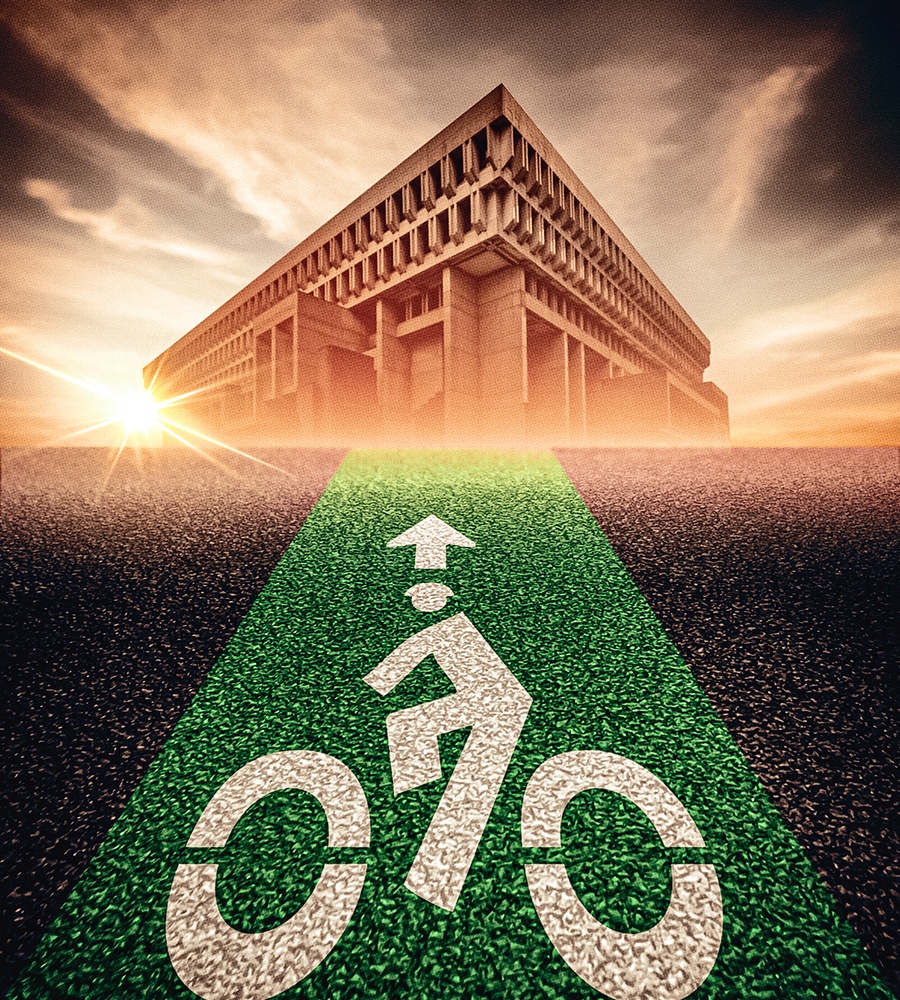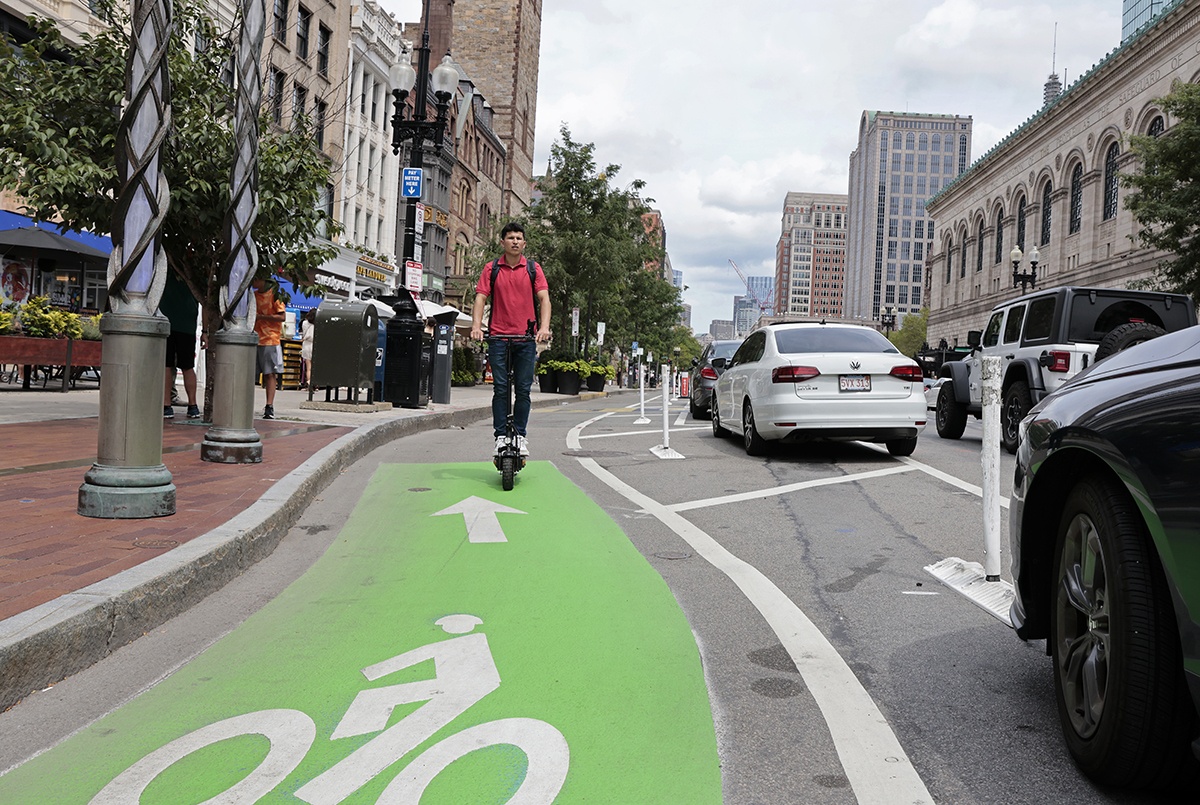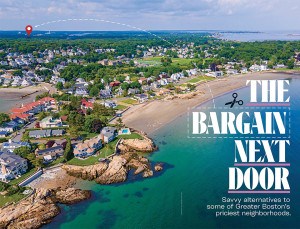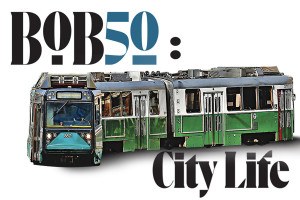This Bike Lanes Story Isn’t Really About Bike Lanes
City Hall’s ambitious plan to reshape Boston’s streets has ignited a battle over who really controls the town’s future—and exposed an identity crisis long in the making.

Illustration by Benjamen Purvis / Photo by Keith Bedford/the Boston Globe via Getty Images
For decades on Brighton’s Western Avenue, neighbors and others in the know have flocked to Big Daddy’s Pizza & Sub Shop for massive slices of creative pizza (scallion and peppercorn steak, chicken bacon ranch), voluminous chicken Parm subs (“weighing in at more than one and one-third pounds”), and dozens of other diet-busting delights. It’s the kind of place where Boston’s eternal sign of a worthwhile feed—cop and firefighter customers—wait their turn with students, office workers, and townies in a line that often extends out the door.
Or rather, used to. On a recent weekday, the place was nearly deserted at noon, the unusual stillness punctuated only by the phone ringing with delivery orders. “Thank God we do delivery,” said manager Diljit Singh, who claimed the shop’s revenue has recently tanked by nearly 40 percent.
So what happened to Big Daddy’s? You could say it’s been crippled by a diet. Not a New Year’s resolution by sub-fattened Bostonians, but the latest of many “road diets” subtracting large numbers of parking spaces in favor of protected bike lanes, courtesy of the administration of Boston Mayor Michelle Wu.
Last fall, workers began replacing parking on both sides of Western Avenue between Barry’s Corner and the Birmingham Parkway with wide bike lanes, the fulfillment of a two-year-old promise to reform the “management of curbside use regulations for the benefit of all,” as the Boston Planning and Development Agency’s rezoning document puts it. A survey of the neighborhood, the city claims, aligned with the mayor’s commitment to getting cars off the streets to ease congestion and promote pedestrian safety: “While short-term customer and visitor parking was noted as a need, survey respondents also observed that more bicycle parking, safer bicycle infrastructure, and improved transit were needed,” reads the planning-agency report.
The latter argument won big. And for Big Daddy’s, the prioritization of bike lanes on a stretch of Western Avenue where its customers could once easily find short-term parking feels like a death knell. “They’re killing my business,” Singh says. “I’ve had customers say they’re gonna stop coming because they can’t park. They leave sometimes without picking up their order because they can’t pull over.”
This furious businessman has plenty of company. Of all the current policy disputes between Bostonians and their government—from tax rates to development to education—the backlash against bike lanes feels among the most heated. And as another mayoral election looms, this seemingly benign urban planning detail has, like a severely overinflated tire, exploded into shards of toxic political fallout.
In a recent series of privately funded focus groups of Boston residents, organizers were stunned at the ferocity of opinion on the issue. “The groups universally felt that the bike lanes have gone too far,” reads a summary of the discussions. “Even cyclists agreed with the complaints. The bike lanes make it difficult to get around and take up parking spaces. For many, the salt in the wound is how the bike lanes (along with the bus lanes) are largely unused. This is a sore spot voters have with Wu.”
The backlash is already shaping this year’s mayoral race: Challenger Josh Kraft has seized on the growing discontent. “Moving around Boston has become a burden for families, seniors, and members of the disabled community,” Kraft says. “While I’m all for being creative about how we solve our transportation challenges, our ‘transportation problem’ under the Wu administration has quickly spiraled into a ‘quality-of-life problem.’”
(As this article went to press, the mayor moved to calm the cycle of discontent. A controversial Boylston Street bus lane was scrapped. And in an internal memo, the mayor initiated a “30-day review” of “street infrastructure changes from the last 3 years” to show “how community input shapes post-project follow-up.” Wrote Wu in a letter to Back Bay civic and political leaders: “I have heard from you and other community members that the process to evaluate these tradeoffs … has at times felt rushed and predetermined.” Two Basic City Services officials are leading the review, while controversial chief of streets Jascha Franklin-Hodge has been relegated to a supporting role.
According to biking advocacy website StreetsblogMASS, the three-year review period could include the contentious Back Bay bike lanes, a protected lane on Mass Ave between Everett Square and Melnea Cass Boulevard, and the Western Avenue bike lane that has reportedly devastated business at Big Daddy’s.)
In fact, depending on the neighborhood, bike lanes are being blamed for worsening the congestion they are supposed to help alleviate, driving away commercial investment and elderly residents, and choking off access to restaurants, stores, and services for customers who can’t use a bike to do their business. Few people, if any, are outright against bike lanes, but what started as some simple two-wheeled paths has erupted into nothing less than a fight for Boston’s soul. Bike lanes have become an ideological proxy battle where many major tensions converge—young versus old, cyclists versus drivers, urban versus suburban, business owners versus city visionaries, longtime residents versus newcomers. And beneath the heated arguments over parking spaces and traffic flow lies a far more profound question that’s tearing at the fabric of neighborhoods across the city: Who gets to decide what Boston becomes?

The Boylston Street bike lane last August. / Photo by Pat Greenhouse/The Boston Globe via Getty Images
Taken at face value, bike lanes are unlikely villains. Various studies have shown that bicycling promotes personal health and replaces the noise and pollution of cars with quiet, clean transport. Bikes can also, in a region known for reckless drivers, promote safety. “My plan is for Boston to be the most family-friendly city in the country,” says Wu, who has made streetscape reform part of her political brand from day one. “I live in Roslindale, my family’s on Centre Street. I know what it feels like crossing the street holding tight to the kids’ wrists.”
It makes sense, then, that a 2021 survey of Boston-area residents by the MassINC Polling Group found 75 percent backed building more bike lanes that are separated from car traffic. “Bikes and e-bikes will play an important role in increasing access to reliable, affordable transportation in Boston and in helping to address the climate, safety, and congestion impacts of our over-reliance on automobiles,” said the city’s chief of streets, Jascha Franklin-Hodge, in a September 2022 announcement of the bike-lane expansion program.
Who could reasonably argue with him? Boston ranked fourth among U.S. cities in the most recent Global Traffic Scorecard of most congested urban areas, with an average downtown speed of 13 miles per hour, on par with New York City (only Washington, DC, has a slower crawl). It’s been understood for decades that fewer cars clogging the old city’s narrow streets and spewing exhaust as they idle was a desirable goal; the Big Dig was conceived as a major step toward reducing surface-car traffic downtown, and both of Wu’s predecessors, the late Tom Menino (an avid bicyclist) and Marty Walsh, were advocates of bike lanes.
But a citywide chorus of critics is saying the bike lanes—used by a single-digit percentage of travelers—aren’t making it easier for the vast majority of residents and visitors to move around. While most acknowledge that a less car-dependent future is inevitable and a good thing, they argue it’s unfair to curtail automobile access before better, or at least equivalent, alternatives exist: The T is still struggling to attract riders and run on time; dedicated bus lanes eventually empty into the general traffic stall; and Boston’s frigid weather can render biking moot for even the most dedicated cyclist.
Boylston Street in the Back Bay has become a prime case study in what rankles critics. On a late-morning stroll down Boylston on a sunny winter day, we saw all parking spots taken and heavy car and pedestrian traffic. But the bike lane was empty, save for a few food-delivery scooters waiting to pick up orders at Chick-fil-A. Customers filled the Apple store, but there was no sign any of them had arrived by bike; at the nearby Bluebikes rental stand, bicycles sat unused in 14 of the 18 portals. Meanwhile, a truck was wedged in a crosswalk well away from its delivery address, the only place the driver could find to unload, he told us. “I’ve been at it for an hour already,” he said, rolling his eyes. Between the double-parkers and the city’s addition of a bus lane on the Copley Square side of Boylston, vehicle traffic was slowed to a crawl, resulting in near-gridlock on side streets. “They took a functional neighborhood that had capacity and a business organization that supported bike lanes and created an unworkable street configuration,” says Meg Mainzer-Cohen, executive director of the Back Bay Association. At least the deserted bike lane on Boylston was serving one unexpected purpose: A pedestrian using mobility aids was able to avoid the crowded sidewalk.
The same scenario is unfolding on Tremont Street in the South End, according to longtime city resident Jim Anderson, who owns a small stained-glass business. “They took out so many parking spaces and made it impossible for commercial vehicles to park. It’s turned into a nightmare, and nobody uses the bike lanes,” he says. Setting aside the wisdom of trying to take stained glass home in a bike pannier, most of his customers—and, he suggests, many who patronize South End restaurants and shops—don’t live within biking distance. “It’s ruining the commercial traffic and putting off suburbanites from coming in and eating and shopping.” Prominent developer Bruce Percelay, who owns commercial properties throughout the city, agrees. “The city’s bike-lane project is a triumph of ideology over rational thought,” he says. “Helping small businesses and property owners and reducing traffic mayhem seems to have taken a back seat to imagery and wishful thinking. Utopian ideas look good on paper, but unfortunately we all live in reality. Perhaps the city should budget for their inevitable removal.”
And it isn’t just downtown businesses and visitors gagging on the city’s force-fed bike-lane diet. In Mattapan, the rollout last fall of city plans for redesigning a large stretch of Blue Hill Avenue to include new bus and bike lanes has been met with severe skepticism. Grove Hall resident and longtime neighborhood activist Laura Younger slammed the city’s plan in a Bay State Banner op-ed, predicting some of the same undesirable side effects that have infuriated the Boylston Street critics: “We truly believe from past experience that there will be a shifting of traffic flow, parking, and congestion from [Blue Hill Avenue] to the side streets (along with the pollution).”
Even Wu acknowledges that not everyone may agree with the city’s approach to bike-lane design. “In your home, if you move around the furniture in the living room, there are some principles about how [it] might be laid out, but it might be different in your particular family,” Wu acknowledges. “We have the process of laying out what’s needed through big-picture vision.”
In Boston and other progressive communities, though, the grand visions of bike advocates are in perpetual tension with those of folks dismayed to find their living rooms, by bureaucratic diktat, no longer include room for their favorite chair—or chariot. Ward One Somerville City Councilor Matthew McLaughlin, himself an avid biker, suggests the angry rhetoric that often saturates bike-lane debates speaks to underlying cultural and ideological divisions. “Especially when it comes to separated bike lanes,” he says, “sometimes the fervor feels religious.”
Today’s tensions have historical context: While neither of Wu’s immediate predecessors were without their grudges and blind spots, both proved their ability to swallow defeat and move on when the community said no (see: Menino’s coveted Suffolk Downs casino plan and Walsh’s 2024 Olympics bid). But while modern-day Boston has branded itself as an oasis of collaborative politics, where the neighborhoods share power with City Hall, to hear a range of neighborhood activists tell it, an emerging theme of this mayor’s tenure has been Wu is from Venus and a critical mass of city residents are from Mars.
The disconnect was palpable over the mayor’s plan to transfer the John D. O’Bryant School of Mathematics and Science from Roxbury to the old West Roxbury Education Complex site at the other end of the city, a since-discarded move that blindsided many in the Black community, who saw it as disenfranchising. The leasing of White Stadium in Franklin Park to a professional women’s soccer team exacerbated that anger. And commercial property owners already feeling beleaguered by Wu-era tax and rent-control proposals were further alienated by her failed bid to balance the budget by boosting their tax rate.
Yet at every turn, and especially when it comes to bike lanes, the critics say what frosts them most is City Hall’s habit of listening with a closed mind. The South End Business Alliance’s Randi Lathrop, a development consultant, urban planner, and former Boston Redevelopment Authority staffer under Menino, recalls both Menino and Walsh engaging in an “intense public process” that often resulted in changes to or withdrawal of city plans. But she finds the Wu administration oblivious to community concerns. “They listen but do what they want anyway,” she says. “Their attitude is ‘We own the streets, so we’re gonna do what we want.’”
Sheila Grove, a longtime South End civic activist who worked on the Menino-era redevelopment of Washington Street, has the same experience. Back then, she says, “we had a true community process. Today, we don’t have any community process. Redoing the streets is really important. The city says they talk with everybody, but they really didn’t talk to them and listen. They have community meetings just to write down they had community meetings, and it really doesn’t go anywhere.” Adds Tanisha Sullivan, president of the NAACP Boston Branch: “What we hear across the city from residents is that they don’t feel as if their voices are being heard. They do not feel as if they are an active part of the evolution of this city, that it feels very top down, ‘Here’s the cake, are you going to eat it? We might be able to change the frosting, but the cake is baked.’”
Disappointment, dismissal, and the mistrust they create can breed cynicism and strife, as our national politics demonstrate. Factor in the generation gap between younger biking aficionados and older, more car-reliant residents, and you have a formula for conflict. That’s why past Boston mayors proceeded carefully, at times pulling back bike-lane expansion plans when community opposition was intense. “You have to be more strategic,” Walsh says. “I support bikers and think it’s a great mode of transportation, but when you’re dealing with the public as a mayor, everything’s political. You represent the entire city, and I don’t like to divide the city up.”
But City Hall says people have it all wrong. “If I look at the scope of the projects, I cannot think of one that has not changed as a result of community input and feedback,” Franklin-Hodge says. “But we are obviously going to bring our expertise to bear. It’s important that people feel heard, and the perspectives that people share with us get thoughtful consideration from the city, but that doesn’t mean a specific individual or group of individuals is in a position to say, ‘Well, we don’t want that project.’”
Walsh disagrees sharply. “No community should be forced to have [a bike lane] if they have valid concerns,” he insists. Wu stands firm, arguing that her administration must look beyond immediate political pressures. “So many of these traffic safety challenges exist because politics was put before hard decisions,” she says. “We have to move forward rather than having these same conversations over and over again.”
Wu also rejects the claim that her administration takes a bike-way-or-the-highway approach, citing a couple of cases where road diets have been altered in response to community outcry, including one of the most bitterly contested projects, the redesign of Centre Street in West Roxbury. “There’s always an opportunity to review and adjust,” she says, repeatedly stressing that bike lanes are a manifestation of broader principles that she explicitly campaigned on. “Everything that the city does we are making sure that it meets the moment and making sure it’s what residents need now and into the future,” she says.
As she looks to the future, though, it may also be wise to look north. It’s game on right now in the progressive environs of Toronto, where the Ontario provincial government last fall cleared the way for the removal of three controversial bikeways in downtown, citing the need for, as Transportation Minister Prabmeet Sarkaria put it, “a common-sense approach to installing bike lanes on city streets to ensure they don’t impede the flow of traffic.” And according to news outlet CBC, the crackdown isn’t stopping there. If the province determines that future bike-lane proposals would worsen congestion, “they will not get built,” Sarkaria vowed. A lawsuit by cycling advocates has since delayed the lane removals, and the situation has devolved into familiar conflicts between businesses and bikers, car-centric suburbanites and urban cycling enthusiasts, and so on.
Still, says Franklin-Hodge, despite Boston’s uniquely chaotic street grid, “we look at best practices around the world.” Asked to cite an urban role model, he mentions Montreal as “a great example of a winter city that has made some really thoughtful choices.” Uh-oh. His exemplar is currently engulfed in controversy with a familiar ring. A group is currently planning to sue the Montreal government over what it claims has been a heavy-handed, arrogant dismissal of their concerns over the city’s rapid bike-lane expansion. “Nobody is against bike paths,” Marc Perez, the group’s director, told the Montreal Gazette. “Everybody’s just against the policies and the way they’re being implemented.”
So why can’t we all just get along? Wu says her administration is “absolutely” open to compromises moving forward, conceding that “no process is perfect.”
So why can’t we all just get along? Wu says her administration is “absolutely” open to compromises moving forward, conceding that “no process is perfect. It’s a sprawling, unending landscape that we are trying to find consensus on.” The mayor says the city has responded to concerns by fixing signal timing, rearranging markers and the flexible posts that border the bike lanes, and even putting some parking spaces back in.
Over on Western Avenue, though, Big Daddy’s manager is still begging for some moderation. “Why did they put in two lanes? Why not just one?” asks Singh, who offers some street wisdom Wu might be wise to heed. “She’s gonna be in trouble if this keeps up. Tell me: Who’s gonna take their pizza home on a bicycle?”
An earlier version of this article was first published in the print edition of the March 2025 issue with the headline: “This Isn’t About Bike Lanes.”


